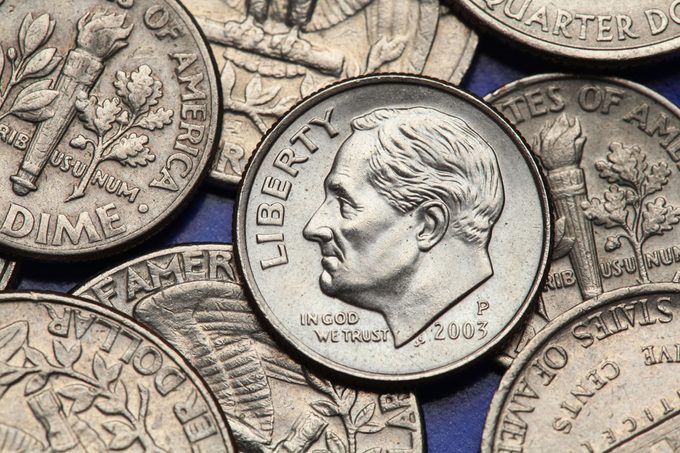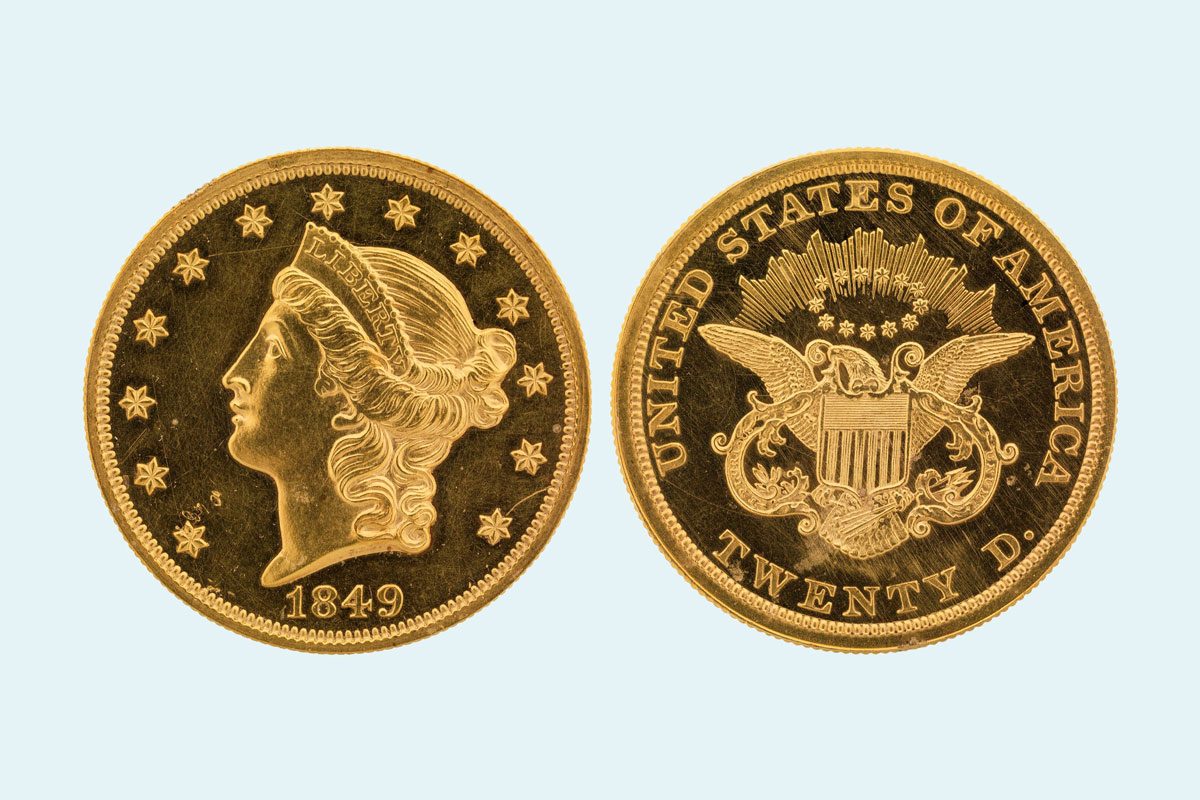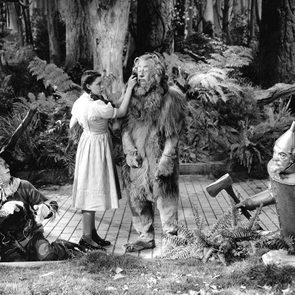You’ve never had a better reason to break open that old piggy bank! Here's how to tell if you have one of these rare dimes.

If You Have One of These Rare Dimes, You’re Sitting on More Than $2 Million

Personally, my couch cushions aren’t just for comfy sitting. They also double as a snack graveyard. (What do my kids think really happens to those wrappers they shove down the cracks? Do they think we have house elves?) But for some lucky folks, their couch cushions double as treasure chests—and yours might be one of them. No, I’m not talking about a random $5 bill or that single earring you lost in 2018. I’m talking about the kind of treasure that allows you to retire early.
Somewhere—maybe in your couch, a change jar or your grandpa’s suspiciously heavy sock drawer—there could be coins worth hundreds of thousands or even millions of dollars. These rare finds are easy to overlook, but they are worth the hunt. And the crown jewel of coin collecting is one humble little dime. (Yes, someone did accidentally spend one of these rare dimes on gum. We’ll get to that tragedy in a minute.)
“These are the types of rare coins that make coin collecting so fun. It’s that thrill of the chase,” says numismatist Neal Paul, a certified expert in rare coins and professional coin collector who has owned some of the rarest coins in the world. “It’s that idea of: Everyone has coins, so what if you do happen to have one just laying around?”
But before you flip the couch and empty out your coin jars, keep reading to learn why one tiny 10-cent piece is worth a fortune—and how to spot one if you’re sitting on it. Literally.
Get Reader’s Digest’s Read Up newsletter for more fun facts, humor, cleaning, travel and tech all week long.
Why are some coins so valuable?
Spoiler alert: It’s not because they’re shinier. In fact, these antique coins often don’t look like much. Coins become valuable for a few reasons: scarcity, minting errors, eye appeal, design, historical significance, condition and the amount of money they are worth. But sometimes, it’s just the thrill of the hunt. Coin collectors love a good mystery.
“For me, coin collecting started as a fun hobby and learning experience, but it’s since turned into an investment and a business,” Paul says. “I owned a mint-condition 1877 Carson City trade dollar—one of the rarest coins—that I was able to sell a few years later for double the price.” Although, he adds, he felt some sentimental attachment to that coin and he wishes he hadn’t sold it.
Fun fact: The phrase “mint condition”—which means something is in perfect, original condition—originates from the idea that a freshly minted coin is flawless. And when it comes to coin value, condition is everything. A pristine coin can be worth exponentially more than one that’s been rattling around in people’s pockets for decades.
What is the most valuable dime in existence?

Drumroll, please. … It is the 1894-S Barber dime, named for the engraver who designed it. This unassuming dime fetched $2.16 million an auction in January 2025, according to the Professional Coin Grading Service (PCGS), which provides the global standard for rare-coin grading.
Why is this dime so rare?
This is the (ahem) million-dollar question. In 1894, for reasons historians still debate, only 24 Barber dimes were created at the San Francisco Mint. The most popular theory is that it had to do with end-of-fiscal-year bookkeeping. As the story goes, the mint’s annual audit showed a discrepancy of $2.40, so the dimes were struck to compensate for this. Other theories? Mint employees made only a few as gifts for important bankers, or they were used as a test run for the metal dies that print the coins.
“The history of it, the story behind why there are so few, is what makes it so fascinating,” Paul says. “I’ve owned a number of [the less rare types of] Barber dimes, but I’ve never had a chance to see a 1894-S. That would be a dream!”
Regardless of why there are only 24, we know what happened to at least one. Legend says the mint’s superintendent gave three to his daughter … who promptly spent one on ice cream. Which is exactly what a child would do with gifted money. But it also means that someone once traded a future $2 million fortune for a scoop. Hopefully she at least got a really good flavor! As for her other two, she sold them to collectors in the 1950s.
Where are the dimes now?
Of the 24 minted Barber dimes, only nine are known to have survived. The rarest of the 1894-S Barber dimes is preserved in the Smithsonian National Numismatic Collection, and the rest belong to private collectors.
When asked about the remaining 1894-S dimes years later, John Dagget, the San Francisco Mint superintendent of 1894, said: “One would think that other examples would have surfaced with all the publicity surrounding this coin, not to mention the ever-increasing value of this rarity. However, such has not been the case. The remainder of the coins struck were probably lost or re-melted at some point. The discovery of a new example would be truly exciting news.”
Could someone still find one of these valuable dimes at large? “It would be incredibly rare, but technically yes, there’s always the hope that someone’s great-grandfather stashed one in a sock drawer or something,” Paul says. “And that’s what makes coin collecting so exciting.”
How can you tell if you have one of these rare dimes?
Even though the chances are incredibly slim, people post about them fairly regularly in coin forums, including one Redditor who was sure he had one. But most of these are likely counterfeit. “There’s a lot of bad information and scams about coins online,” Paul says. “Never use a website to try to authenticate a coin yourself.”
Instead, he recommends looking up a local coin shop—preferably one that’s been around for decades and has good reviews—and have it assessed in person. If that expert thinks it may be legit, then you need to pay to have it professionally graded. In fact, the only way to know for sure if you have a real rare coin is to have it authenticated by a professional coin grading company, usually through the Professional Coin Grading Service (PCGS) or the Numismatic Guaranty Company (NGC).
Before you send it in, make sure it meets all the requirements on the Barber dime checklist:
- Year: 1894
- Mint mark: Look for an “S” below the wreath on the back (for San Francisco)
- Design: Liberty head on the front, “ONE DIME” inside a wreath on the back
- Condition: While pristine condition skyrockets the value, even a worn one is worth a small fortune
- Weight: About 2.5 grams
If you even think your dime meets these criteria, get it authenticated. Do not, under any circumstances, try to clean it. You might scrub off six figures.
What are some of the other rarest dimes and coins out there?

The rarest and most valuable coin in the world is the 1849 double eagle gold coin—worth around $25 million. There’s only one left, and it’s preserved in the National Numismatic Collection at the Smithsonian Institution.
And here are some other all-stars, with their approximate worth valued in mint condition:
- 1933 double eagle quarter: $18.9 million
- 1794 flowing hair dollar: $12 million
- 1822 half eagle: $8.4 million
- 1804 dollar: $7.68 million
- 1861 Paquet liberty head double eagle: $7.2 million
Most valuable dimes (after the Barber dime):
- 1873 Carson City seated liberty dimes: $1.84 million
- 1796 and 1797 draped bust dimes: $40,000
- 916-D Mercury dime: $39,000
How do you cash in if you find one of these rare coins?
Step 1: Remain calm.
Step 2: No DIY cleaning.
Step 3: Get a reputable coin dealer or grading service (like PCGS or NGC) to authenticate it.
Once authenticated, you can choose to auction it (Heritage Auctions and Stack’s Bowers are top choices), sell it to a collector (often faster but possibly for less than auction value) or contact a rare-coin broker (they’ll take a cut, but it’s hassle-free).
“If you’ve got one, there’s always someone looking to buy,” Paul says. “The coin industry is very lucrative right now.” He notes that at a recent conference, he watched a professional collector spend more than $2 million in two days on coins.
So it’s certainly worth it to look at your coins. At best, you could become filthy rich overnight. At the very least, it will inspire you to clean out your couch and pockets more often, and that’s never a bad thing!
About the expert
|
Why trust us
At Reader’s Digest, we’re committed to producing high-quality content by writers with expertise and experience in their field in consultation with relevant, qualified experts. We rely on reputable primary sources, including government and professional organizations and academic institutions as well as our writers’ personal experiences where appropriate. For this story on rare dimes, Charlotte Hilton Andersen tapped her experience as a longtime journalist for Reader’s Digest. We verify all facts and data, back them with credible sourcing and revisit them over time to ensure they remain accurate and up to date. Read more about our team, our contributors and our editorial policies.
Sources:
- Neal Paul, numismatist, certified expert in rare coins and professional coin collector; phone interview, May 6, 2025
- PCGS: “1894-S Barber dime”
- Coin World Almanac 1977
- NGC: “Jeff Garrett: Collecting Barber Coinage”
- Gainesville Coins: “Most Valuable Dimes”
- Reddit: “My FIL has this ‘1894 S Barber dime proof.’ It’s passed all of the tests he knows to determine if it’s real.”























